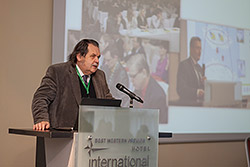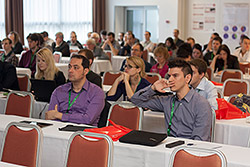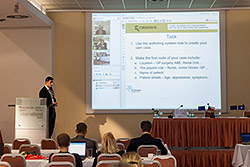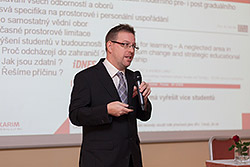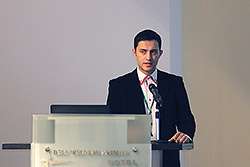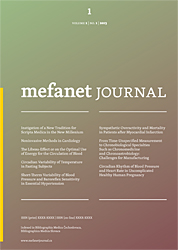
MEFANET Journal 2015; 3(1): 28–31
EDITORIAL MATERIAL
8th year of the MEFANET conference: virtual reality is breaking down barriers
Jakub Gregor, Martin Komenda, Daniel Schwarz*, Ladislav Dušek, Lenka Šnajdrová
Institute of Biostatistics and Analyses, Faculty of Medicine, Masaryk University, Czech Republic
* Corresponding author: schwarz@iba.muni.cz
Abstract
Article history:
Available online: 27 April 2015
Download PDF
Supplementary material
With a slight overstatement, one could say that the 8th year of the MEFANET conference reached boundaries of the solar system, which can boast eight planets. In reality, ambitions of the Czech-Slovak cooperation in the area of medical education are more modest, but this year’s programme has demonstrated that the international cooperation surely extends beyond the former federal boundary of Czechoslovakia.
Keywords
MEFANET; medical informatics; e-learning; virtual patient; e-assessment
Teachers, students and experts interested in modern methods of medical education met as usual at the end of November in the Hotel International, not far away from two dominants of the City of Brno. The conference was ceremonially opened by Prof Jan Žaloudík, Chairman of the Committee on Health and Social Policy of the Senate of the Parliament of the Czech Republic, and recently the director of the Masaryk Memorial Cancer Institute in Brno, and by Prof Aleš Ryška from the Fingerland’s Department of Pathology at the University Hospital Hradec Kralove.
Figure 1. Conference opening by Professor Jan Žaloudík
Figure 2. Christos Vaitsis (left) and Sokratis Nifakos participated not only as lecturers, but also as attendants, because English was the official language on the first conference day
Figure 3. Workshop inspired by the CROESUS project, with a teleconference participation of colleagues from London
Figure 4. Dr Petr Štourač opens the session dedicated to e-learning and simulations in acute medicine
Figure 5. Dr Daniel Schwarz was elected the new Chairman of the Coordinating Council of the MEFANET project
A summary of key activities, recent successes and new challenges for the MEFANET network became a regular, keenly anticipated part of the conference opening. Similarly to the last year, Dr Daniel Schwarz (IBA, MU’s Faculty of Medicine) took the floor, presenting a lot of positive information and good news. Namely, dr Schwarz introduced the new appearance of the MEFANET gateway, which transformed the current e-publishing platform into a “web-scale discovery” system enabling a more elaborate indexing, and a more precise search of articles. A recently published book entitled “Computer Applications, Systems and Netwoks for Medical Education. MEFANET: Czech and Slovak Medical Faculties Network” is another piece of good news, pointing to the impact of various forms of e-learning on the education process in different medical specialties, documenting the approaches to a simulation-based education, and last but not least, introducing the MEFANET network itself and its key role in the involvement of information and communication technologies in the education of physicians and other health professionals. Dr Schwarz also highlighted the importance of activities which attract and involve students in the education process, namely AKUTNE.CZ and WikiSkripta. He did not miss out other interesting national and international project linked to the MEFANET network, including the MEFANET Journal, which would complete its second year in December 2014. Several individual sessions of the conference were dedicated to selected activities of the MEFANET project, as mentioned further in this article.
But first, another integral part of the conference needs to be mentioned, i.e. keynote lectures of invited foreign guests. This year, Sokratis Nifakos and Christos Vaitsis (both from the Karolinska Institutet in Stockholm, Sweden) accepted the invitation. Sokratis Nifakos focused on mobile technology and its use in the education of both students and doctors. For example, he presented the so-called augmented reality, which is “a live direct or indirect view of a physical, real-world environment whose elements are augmented (or supplemented) by computer-generated sensory input such as sound, video, graphics or GPS data”, as defined by Wikipedia. The prescription of antibiotics and three-dimensional models in cardiology were provided as examples. In the latter lecture, Christos Vaitsis dealt with the processing of big data, which needs to be done when preparing an education programme, teaching materials or electronic testing, as well as visualisation of such data, based on the so-called “visual analytics” approach. He emphasised several aspects, such as the necessity of providing a balanced amount of information (lack versus oversaturation), the correct definition of roles and targets, or putting oneself in the place of end users when developing any outputs. Development and optimisation of a study plan (whether it be the entire field of study, or a single course) was likened to a path on the map, which involves intermediate and final targets of the education process.
As mentioned above, two conference sections were dedicated to projects which are somehow linked to the MEFANET network. The OPTIMED project (http://opti.med.muni.cz/en) is one of them: this project, which is being solved at the Faculty of Medicine at Masaryk University (MU), aims to innovate the General Medicine field of study in its entirety: both compulsory and optional courses will be dealt with. This project is unique by the development of an entirely new dynamic system, which will ensure an effective communication between students and teachers on the levels of not only theoretical and pre-clinical courses, but also in practical courses. The system is based on the proposal of a parametric description of a medical curriculum, which can be searched quickly and precisely by the OPTIMED platform. Lectures in this session were intentionally designed in a manner which would introduce the motivation and the theoretical background of the entire project (a lecture given by Assoc Prof Julia Bienertová Vašků from the MU’s Faculty of Medicine), and demonstrate its real use for the study of medicine (as explained by Dr Komenda from IBA, MU’s Faculty of Medicine). The final lecture was presented by Jan Svancara, MSc (IBA, MU’s Faculty of Medicine), who summarised the available data describing the education from the analytical point of view, and indicated that a properly designed database background would make it possible to view big data describing the curriculum as a whole picture, and to evaluate the education contents globally.
The conference programme continued with a workshop inspired by an international project called CROESUS, which involves the mutual cooperation of St George’s, University of London (United Kingdom), Masaryk University (Czech Republic), and Pavol Jozef Šafárik University in Košice (Slovakia). Terry Poulton and Sheetal Kavia – two colleagues from St George’s, University of London – participated in the workshop via teleconference. First of all, they informed workshop participants about their perspective and experience with the introduction of innovative methods into the education of medical and non-medical fields of study, such as the educational algorithms, virtual cases or virtual patients, which is the main topic of the CROESUS project. Workshop participants subsequently played an active role in the practical part: with the help of instructors, the participants created nodes of a virtual clinical case, trying out for themselves how the platform for administration of virtual patients works. The concluding discussion turned out to be very useful: both foreign guests answered many unusual questions concerned with the introduction of these modern methods into the education itself.
Despite the very successful social evening, the morning programme of the second conference day was not sleepy at all. Quite the opposite – expressions involving words such as “urgent” or “intensive” echoed throughout the lecture theatre, as interesting topics from acute medicine were on the programme, chaired by Dr Petr Stourac (Department of Anaesthesiology, Resuscitation and Intensive Care Medicine, University Hospital Brno). Virtual patients and simulations play an important role particularly in acute medicine, because the opportunities to involve students in real cases are obviously very limited. After all, simulations are perceived as a separate scientific discipline in the field of acute medicine, and many new tools and procedures are tested in simulations before being introduced into practice. This medical specialty is also rather specific from the point of view of a smooth running of the medical team, numerous interactions, and a limited time for making decisions – and all of these are obviously very difficult to encourage, teach and examine by ordinary methods of education. Electronic publishing and simulations also help the staff of non-university hospitals, who have rather limited opportunities to be in contact with leading experts in the field. Other conference sessions focusing on medical informatics, information science and generally ICT in the education of physicians and other health care workers also provided many interesting examples and plentiful experience, which were mutually shared by teachers interested in modern technology.
Meeting of the Coordinating Council of the MEFANET project concludes the conference each year, and this year was no exception. The discussion focused on principal points concerning the future of the entire educational MEFANET network, and on activities aimed at specific ways of cooperation among the involved institutions. Election of the Chairman of the Coordinating Council took place at the end of the meeting: Dr Daniel Schwarz (IBA, MU’s Faculty of Medicine) replaced Assoc Prof Ladislav Dusek (from the same institution), who did not stand as a candidate any more. Dr Dusek was officially appointed honorary chairman by representatives of the involved faculties.
Supplementary material
Please cite as:
Gregor J, Komenda M, Schwarz D, Dušek L, Šnajdrová L. 8th year of the MEFANET conference: virtual reality is breaking down barriers. MEFANET Journal 2015; 3(1): 28-31. Available at WWW: http://mj.mefanet.cz/mj-05150420.
This is an open-access article distributed under the terms of the Creative Commons Attribution-NonCommercial-ShareAlike 3.0 License (http://creativecommons.org/licenses/by-nc-sa/3.0/), which permits unrestricted use, distribution, and reproduction in any medium, provided the original work, first published in the MEFANET Journal, is properly cited. The complete bibliographic information, a link to the original publication on http://www.mj.mefanet.cz/, as well as this copyright and license information must be included.
